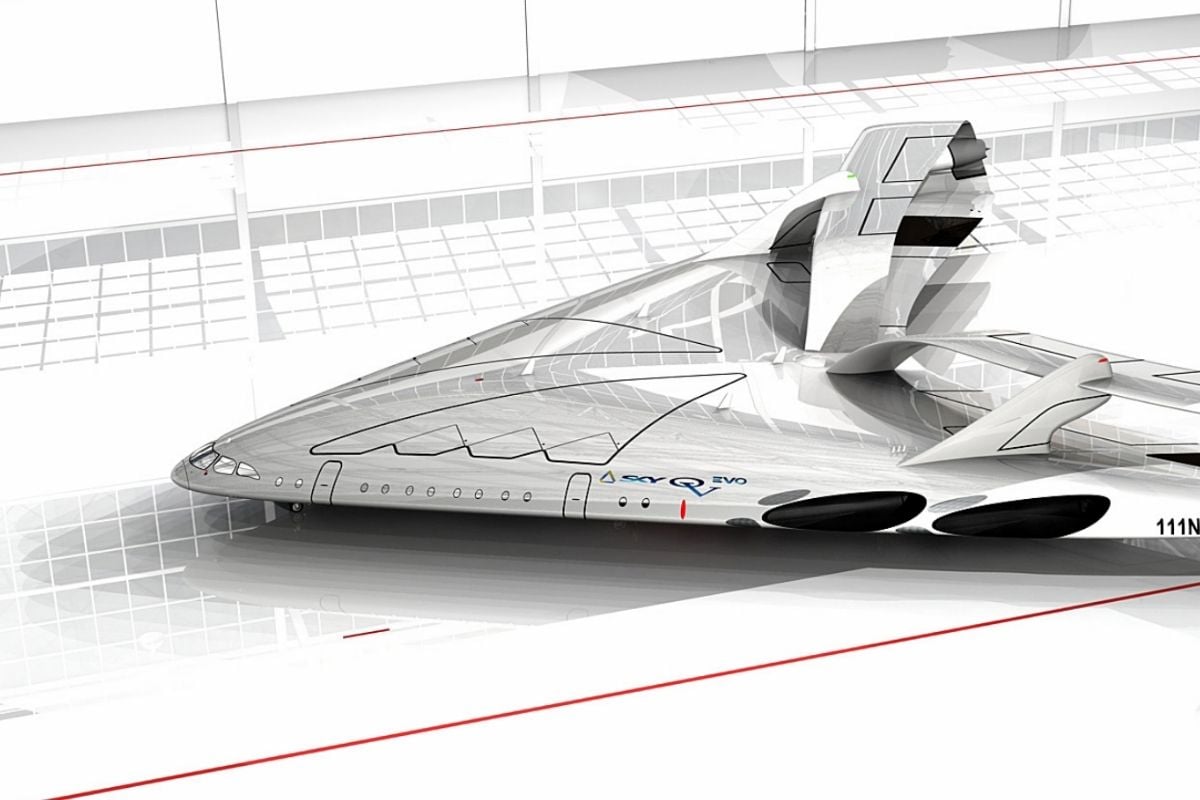A wingless shape built for supersonic speed
A radically wingless airliner concept imagines cruising at 1,837 km/h while leaving fossil fuels behind. Its blended delta body merges fuselage and lifting surfaces into one continuous volume. The result is lower aerodynamic drag and more internal space for passengers and systems.
The architecture echoes the flying-wing lineage, yet with a deeper central volume that improves stability and payload. AI-assisted control surfaces fine-tune the airflow in real time, helping the aircraft stay efficient from takeoff to cruise. At high speed, the smooth planform reduces shock waves and keeps heating under control.
Propulsion without kerosene
Instead of conventional turbofans, the concept combines hydrogen energy with electric power to drive a hybrid propulsion suite. A pulse-detonation-based core is paired with a turboreactor, promising higher thermodynamic efficiency than classic combustion. The aim is supersonic performance with near-zero on-board emissions of carbon dioxide.
Power comes from liquid hydrogen, complemented by solar-harvesting quantum dots on the skin that feed auxiliary systems. Hydrogen offers excellent specific energy, and its water-only exhaust supports a cleaner sky. With fewer moving parts in the detonation cycle, maintenance could be simpler and costs potentially lower.
Materials and smart surfaces
The exterior integrates solar quantum dots that convert light into electricity across a lightweight, high-surface-area skin. Advanced composites keep the structure light while withstanding thermal and mechanical loads at supersonic speeds. Embedded sensors stream real-time structural health data into onboard AI systems.
Micro-actuated control surfaces respond to turbulence with tiny, rapid corrections, trimming drag and boosting stability. This closed-loop approach extends component life and reduces noise from flow separation, especially during takeoff and landing.
Inside the cabin: speed meets serenity
Beyond raw speed, the aircraft promises a quiet, private, and luxurious journey for up to 300 passengers. Suites feature sliding doors, window shades, and sound-dampened walls for genuine in-flight privacy. Dedicated lounges mix leather sofas with dining tables and 32-inch screens for work and leisure.
Premium zones add double beds, spacious showers, and on-board chef service for long-haul comfort. The blended-body layout yields wider aisles and more flexible seating than tube-and-wing layouts. Even at Mach-class cruise, the cabin is designed to feel calm and unhurried.
“Speed without emissions should feel like a privilege, not a compromise.”
Why it matters for the planet and the bottom line
Hydrogen-electric propulsion targets a step change in climate impact, eliminating CO2 at the point of use. Lower exhaust temperatures and smart nozzles are engineered to reduce perceived noise around airports and beneath flight paths. For communities near runways, fewer sonic nuisances could improve daily life.
A lighter airframe and efficient engines translate into lower operating costs compared with equivalent long-haul jets. Reduced fuel mass and smart maintenance further trim lifecycle expenses. For airlines, sustainability and profitability can finally pull in the same direction.
Headline numbers at a glance
- Top speed: 1,837 km/h with hydrogen-electric power
- Range: up to 16,600 km, enabling globe-spanning routes
- Capacity: roughly 300 passengers in flexible cabins
- Emissions: near-zero onboard CO2 during normal operations
- Noise: designed for reduced footprint on the ground and in the cabin
The road from concept to runway
Turning vision into certified hardware requires meticulous design, exhaustive testing, and strict regulatory approval. Hydrogen storage, ground-supply infrastructure, and airport procedures must scale in lockstep with aircraft deployment. Each system—from thermal management to cryogenic tanks—demands industrial-grade maturity.
Timelines will depend on partnerships, funding, and technological readiness across propulsion and materials. Yet the direction is unmistakably forward: cleaner, faster, and more human-centric flight. As enabling tech converges, the first operational routes could redefine transatlantic travel in under five hours.
A glimpse of aviation’s next chapter
This concept reframes the bargain between speed, sustainability, and comfort for long-range travelers. By unifying airframe and propulsion around hydrogen and smart surfaces, it aims to make supersonic flight socially and economically viable. If delivered as envisioned, the aircraft could mark a watershed moment when clean energy and high performance finally take wing together.
The promise is simple, yet profound: supersonic reach, fossil-fuel free.


Lol you call it a wingless plane but it’s literally a giant wing. SMH
Yet it does not exist and will never exist. It’s a “Jetson” reality and your “his boy Elroy”.